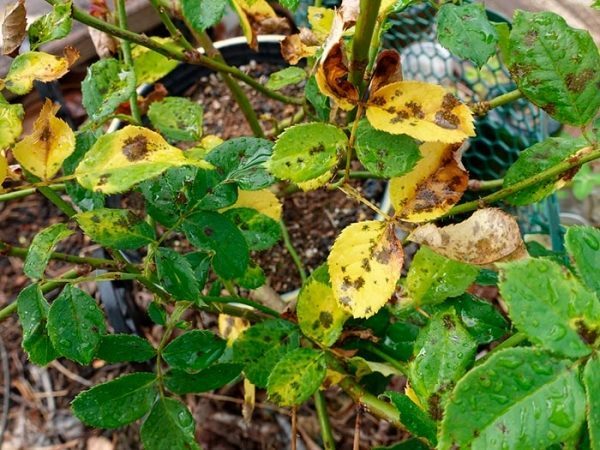
Yellowing and falling of leaves is a natural reaction of roses to a decrease in temperature and a decrease in daylight in the fall. But the appearance of yellow leaves on a bush in summer or spring is uncharacteristic of these flowers and requires the attention of a gardener. Not only spots and stripes, a uniform change in the color of the sheet can also be a symptom of pathological processes.
Content
Possible reasons
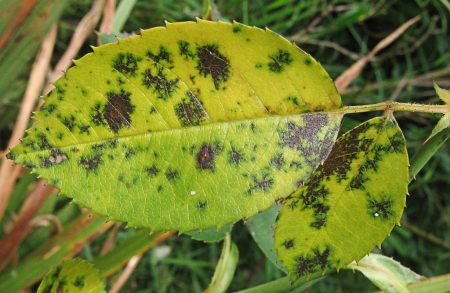
There is no single treatment against yellowing of rose leaves, since various reasons cause such a reaction. Most often, the problem arises as a result of:
- inappropriate care;
- malnutrition;
- exposure to pathogens;
- pest activity on rose bushes.
Environmental conditions
Often the appearance of yellow leaves is provoked by adverse conditions:
- Lack of light. Occurs in roses growing in greenhouses or in shady corners of a garden. The leaves turn yellow on that part of the bush, which receives the least amount of sunlight, the rest of the deciduous cover has a healthy appearance. As a rule, the leaves of the lower tier suffer. The bush blooms poorly, the shoots are unnaturally thin and long, similar to whips, the flowers can be pale and small.
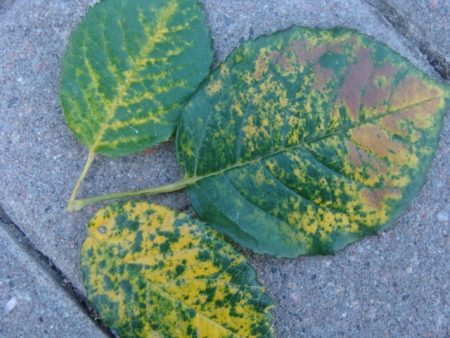
- Waterlogged soil. Long rainy periods or an excess of irrigation have a detrimental effect on the state of the roots of the plant, especially when grown on heavy clay soils or in lowlands, in conditions of poor moisture removal. The first in this case, the lower leaves turn yellow and fall.
Watering rose bushes with tap water can also cause yellowing of the deciduous cover due to the chlorine in the water. For irrigation, it is advisable to use rain, standing water.
- Drought. In addition to yellowing, with a lack of watering, the leaves of roses show twisting of the edges and tips. The yellow color is replaced by a brown, the leaf dries. Also, the cessation of shoot growth and falling flowers are characteristic.
- A sharp change in temperature. In this case, the leaves quickly change color and fall, the bush immediately loses a significant part of the deciduous cover.
Nutritional deficiency
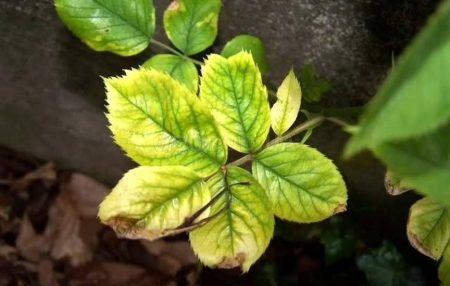
Yellow leaves may indicate a lack of certain nutrients in the diet of the rose:
- Nitrogen. In this case, the leaf turns pale, and after that it acquires an even yellow color. Symptoms first appear on the lower leaves, gradually the entire bush acquires an “autumnal” appearance. In spring, with nitrogen deficiency, deviations in the color of young shoots can be observed - the sprouts become brown-yellow or pale orange, while normally they should have a dark purple color. Leaves on such shoots instead of red become yellow-green.
- Potassium. Old leaves are affected, while the tips first change color, later yellowness “creeps” from the edges to the center, but does not affect the veins. The edges of the leaf plate become brown-violet and dry.
- Calcium. Light yellow spots appear on the leaves, twisting with the edges down is observed. Young foliage grows small in size, the tops of the shoots dry out.
- Iron. Chopping and yellowing, twisting of young leaves is characteristic. Large chlorotic spots appear on old leaves.
- Manganese. The formation of stripes and yellow spots on the lower leaves. At the same time, the veins and small areas of tissue around them retain a green color.Yellowing begins at the edges of the leaf plate.
Rose diseases
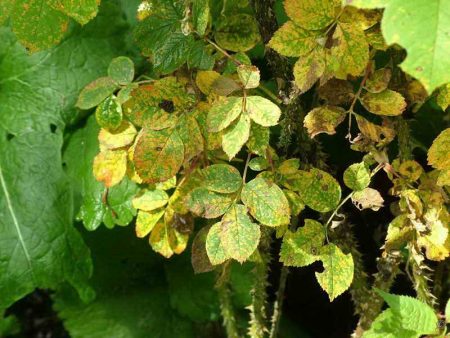
Some fungi, bacteria and viruses are capable of causing yellowing and falling of foliage on rose bushes:
- Black spotting. The disease causes a fungus, symptoms usually appear in the second half of summer. First, brown spots with a yellow border appear on the leaves and stems of roses, after which the leaves turn yellow, curl and crumble. The bush may lose most of the foliage. Shoots cease to grow, flowering does not occur.
- Jaundice. A bacterial disease in which yellowing of the leaves begins with veins, gradually spreading through the rest of the plate. Leaves may curl or rise up.
- Virus mosaic rhesus. Speckles and spots of a yellow-green hue appear on the lower leaves, after a short period of time there is a massive fall of foliage.
- Bronze virus of tomato. Yellowing is preceded by the appearance of bright spots and lightening of the veins in young leaves. After this, the leaves acquire a yellow color, are deformed, necrosis develops on them. An irregular shape of the flowers is noted, spots may appear on the petals.
Rose diseases are often accompanied by a lack of potassium. Black spotting often appears on bushes suffering from a lack of light and waterlogging, bacteria and viruses, as a rule, appear along with the pests that are their carriers. Therefore, treatment should be comprehensive, taking into account all factors.
Pest exposure
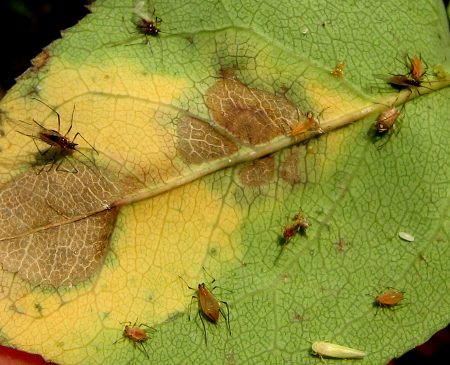
The yellowness of the leaves accompanies the attacks of insects such as:
- Spider mite. The appearance of the symptom is preceded by the formation of many white dots on the leaves, which eventually turn into bleached spots. Ticks are located on the back of the leaves, because of their small size it is difficult to distinguish them with the naked eye. With a large lesion, the leaves appear dusty on the back side, a thin spider web appears on the plant, shoots die off.
- Aphid. Often appears shortly before roses bloom. On young leaves and shoots, small (up to 2 mm in length) insects appear that can have green, red, black, white color. There are also winged species of aphids. The leaves become thinner, curl and turn yellow, areas of sticky plaque appear on the plant. The tops of the shoots are curled up, the buds are deformed and fall off without opening.
- Rosanna scutellum. Appears on roses less often than aphids or spider mites. You can detect the pest by red and yellow spots on the leaves, drops of sticky plaque on the plant, which becomes black over time, stopping the growth of shoots. Gradually, the leaves turn yellow and curl, and white growths are formed on their reverse side and shoots, which are shields covered with wax shells.
- Gall Nematode. Outwardly, the defeat of the nematode manifests itself in weakening of the bushes, in poor flowering, the appearance of small, deformed flowers. The leaves turn yellow, after which they turn brown and curl. If you dig up a diseased plant, you can find swellings and nodules on the roots. These formations are caused by the growth of root tissues, into the thickness of which the pest penetrated.
Resuscitation of roses after exposure to adverse conditions
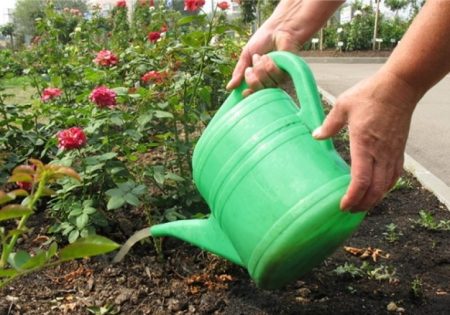
If the roses turn yellow due to poor conditions, first of all, the influence of a negative factor should be excluded. Bushes damaged due to lack of moisture should be poured with warm water, in case of waterlogging of the soil - stop irrigation for a week or take care of a removable waterproof canopy to protect from rain. In case of significant fluctuations in daily temperatures, it is required to provide shelter for the bushes at night. If the reaction of roses is associated with a lack of light, only a transplant to another place will help.
“Resuscitation” measures will help eliminate the effects of stress suffered by plants:
- Water the bushes with Zircon (1 ampoule per bucket). In the solution, you can add the ampoule "Tsitovita" or dissolve 1 g of "Kornevin."Under the bush, you need to pour 1.5-2 liters of funds, immediately before the procedure, pour the plant with clean water.
- After 3 days, it is recommended to treat the bush with the Epin preparation (8-10 drops per 1 liter).
- 14 days after watering, Zircon requires feeding with potassium humate.
If yellowing of the bushes is accompanied by strong inhibition of shoot growth, spraying the bushes with succinic acid solution (tablet per liter of water) or with the drug "HB-101" (drop per liter of water) should be carried out. It is recommended to alternate these products with a solution of vitamin B2 (ampoule per 200 ml of water), performing spraying once a week.
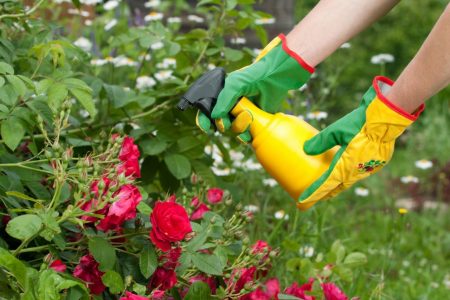
If the roots have suffered (in the case of stagnation of water or prolonged drying of the soil), you need to give the plants an unscheduled feeding with phosphorus - this will help the rose to grow new roots faster. In other cases, weakened plants are enough to feed potassium to increase immunity. The foliar application method is recommended for fast absorption of food - in this case, 15 g of superphosphate or 10 g of potassium sulfate are diluted in a bucket of water. You can combine both elements in one feeding, using potassium monophosphate (10 g per 10 liters).
To prevent yellowing of leaves, the basic conditions for growing roses will help:
- Landing in well-lit areas. In direct sunlight, the bush should be at least 5-6 hours a day.
- Providing drainage of moisture from the soil. When growing in lowland, bushes need to be "raised" above the soil line, that is, planted on an embankment artificially created from the soil. Before planting, sand should be added to heavy soils to loosen.
- Optimum irrigation regime. Rose bushes need to be watered once a week, giving everyone 10 liters of water. If regular care is not possible, mulching the trunk circle with peat or freshly cut grass will help maintain moisture. In the hot summer, irrigation is carried out 2 times in 7 days. Water should be warm.
Replenishment of malnutrition
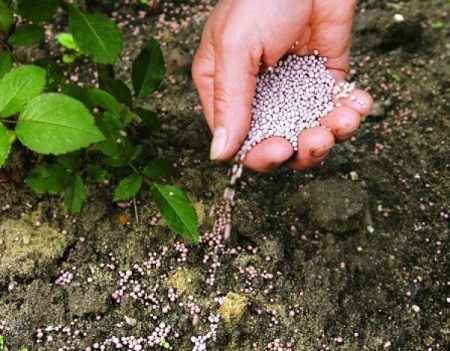
In case of deficiency of nutrients, it is necessary to give roses an unplanned dressing. If dressing with microelements is required (iron, calcium, manganese), spraying the bushes with nutrient solutions is done. Potassium and nitrogen are required to be introduced both through the leaves and into the ground.
- Nitrogen. Root top dressing with carbamide (15 g per bucket - volume for watering 2 bushes) or ammonium nitrate (17 g per 10 l). For foliar feeding, only urea can be used, in this case 5 g of the substance is dissolved in 10 liters. Plants experience the greatest need for nitrogen in the spring.
- Potassium. Foliar top dressing with potassium sulfate (10 g per bucket of water) or potassium nitrate (7 g) is desirable, and Kalimagnesia should be added under the root.
- Calcium. Give calcium nitrate (15 g per 10 liters).
- Manganese. Spraying with manganese sulfate (5-10 g per bucket).
- Iron. For top dressing, solutions of the Micro-Fe, Ferrilen, and Ferovit preparations are used according to the instructions.
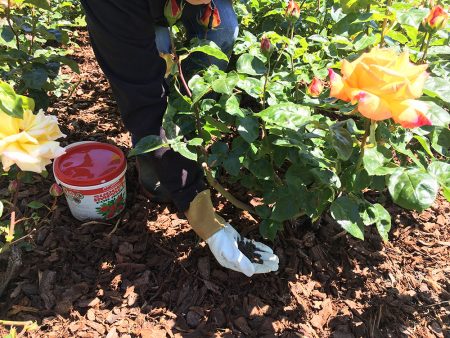
Prevention consists in carrying out all the required dressings for the season and monitoring the condition of the plant. There are additional factors that influence the absorption of nutrients by plants:
- Light and sandy soils are poor in nitrogen. In cold weather and with a deficiency of potassium, plants absorb the element worse from the soil.
- Heavy and peat soils are poor in potassium. The susceptibility of plants to the substance is reduced due to the high content of calcium and magnesium in the soil.
- Calcium is most often found low in acidic and peaty soils.
- A lack of iron and manganese is most often observed in bushes growing on alkaline soils.
Sometimes the soil is alkalized as a result of excessive doses of lime or dolomite flour, introduced to reduce its acidity. The popular method of soil acidification is to dig a small hole near the roots of the bush, into which about 2.5 liters of mullein solution should be poured.
Disease treatment and prevention
One of the worst options is if the yellowing of the leaves is caused by an illness.This symptom is characteristic of severe diseases, some of which (viral) do not have effective treatment regimens.
Black spotting
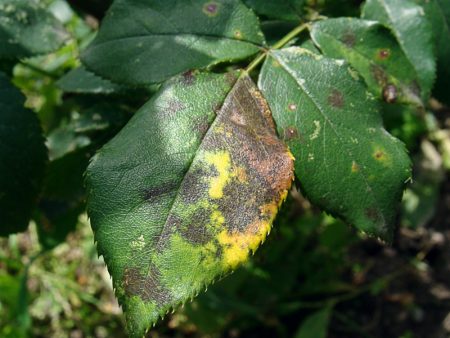
The shoots and leaves of roses that are damaged by the fungus need to be trimmed, after which spraying the bushes. The fungicides Scor, Ridomil Gold, Strobi, Falcon, Profit, and Oksikhom are used to treat black spotting.
Of folk remedies, treatment with copper sulfate solution (1%) or Bordeaux liquid (1%), sulfur solution (0.3%), green infusion, and horsetail broth is effective. Powder dusting of bushes with wood ash is also used.
In order to prevent black spotting, it is recommended:
- Avoid excess nitrogen nutrition. Provide plants with sufficient doses of phosphorus and potassium.
- Take care to bring soil acidity back to normal - the disease often affects roses growing on acidic soils.
- Avoid thick planting of bushes, regularly clean the flower bed or flower bed from weeds.
- Perform preventive spraying of bushes with copper sulfate or Bordeaux liquid twice a year - before the movement of juices in the spring and before wintering.
- During the season, do several treatments of the bushes with the Fitosporin biofungicide (also provides the prevention of bacterial infections).
- Plant lavender or sage near rose bushes.
Jaundice roses
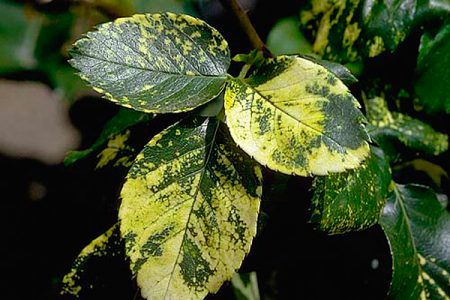
When symptoms of the disease appear, it is necessary to remove damaged shoots and leaves, as well as treatment with antibacterial drugs - Fitosporin, Fitoflavin, Sporobacterin. These biological products are safe for rose bushes and neighboring plantings. Yellowing, spreading throughout the bush, is a signal that the plant should be destroyed. Affected roses, as well as leaves removed during pruning, must be burned.
Prevention of jaundice:
- The fight against insect vectors of bacteria. Jaundice is distributed by circadian plants and leaf flies.
- Disinfection of garden equipment with alcohol or a solution of potassium permanganate (100 g of potassium permanganate in a bucket of water).
Tomato virus mucus virus and bronze tomato
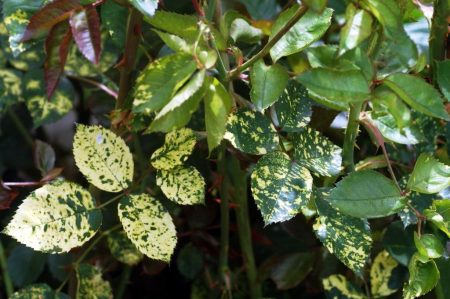
The treatment and prevention of these viruses are the same. In the initial stage of the disease, pruning of the affected leaves and shoots is recommended. Slices should be sanitized with charcoal powder or a pale pink potassium permanganate solution. If the disease continues to progress, it is necessary to dig up and burn the diseased bush in order to stop the spread of the pathogen to other plants. Effective drugs for the treatment of viral diseases in plants do not exist.
Prevention of viruses in roses:
- The fight against any sucking pests of roses - these insects are the main carriers of viruses. Triza mosaic virus most often tolerates thrips.
- The periodic use of special drugs to strengthen the immunity of the plant. For example, "Epin-extra."
- Disinfection of garden tools.
To prevent the virus of bronze of tomatoes, it should be added that the maximum possible distance between planting roses and other crops vulnerable to it - primarily tomatoes and tobacco.
Resistant varieties
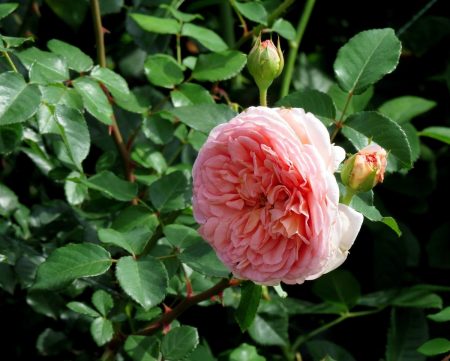
There are a large number of varieties of roses, characterized by a strong immunity against pathogenic microflora. Their choice relieves the gardener of a large layer of worries associated with prevention and treatment. Some of them:
- Remembrance
- Peace
- Westerland
- Leonardo da Vinci
- Golden Wedding
- "Amber Queen";
- “Scarlet Queen Elizabeth”;
- Glenfiddich;
- Arthur Bell
- Chanelle
- Pierre de Ronsard
- Beautiful Britain
- Golden Celebration
- "English Miss";
- "Black Magic";
- Fragrant Delight
- "William Shakespeare 2000";
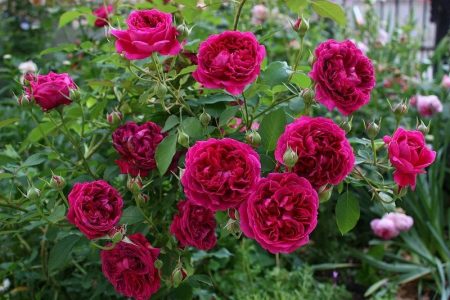
- Anisley Dickson
- "Jubilee Celebration";
- "Fellowship";
- Augusta Luise
- "Anne Harkness";
- "Wishing";
- City of London
- Abraham Darby
- Double Delight
- "The Times Rose";
- Nostalgie
- Harvest Fayre
- "Dame Wendi";
- "Flammentanz";
- Apricola
- Queen Elizabeth
- Cherry Girl
- "Jubile du Prince de Monaco";
- Golden Years
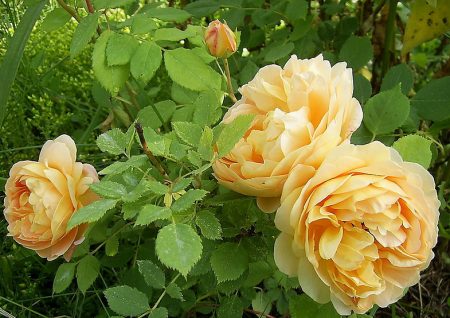
- Aspirin Rose
- Margaret Merril
- Crimson Meidiland
- "Valentine Heart";
- "Escimo";
- Oranges and Lemons
- "Toprose";
- Chippendale
- Korresia
- Chatsworth
- "Princess Alexandra of Kent."
Pest Treatment and Prevention
The most important thing in the fight against any pest is to identify the defeat at an early stage, which increases the chances of a successful outcome of treatment. Therefore, it is advised to regularly inspect the rose bushes and, upon detection of insects, take immediate action.
Spider mite
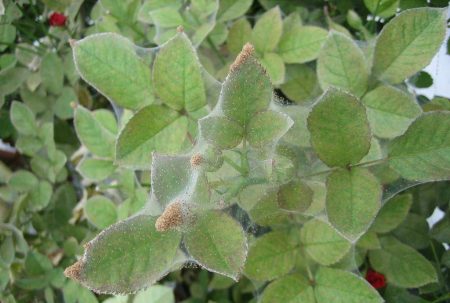
When processing rose bushes against a tick, it should be borne in mind that the bulk of the pests is hidden on the back of the leaves.
Of the chemicals for spraying roses, acaricides are suitable - Neoron, Actellik, Antiklesh, Vertimek, Borneo. The soil in the flower garden is treated with iodine-containing agents, for example, Farmayod or Povidone-iodine.
Folk remedies:
- Soap solution. In 5 liters of hot water you need to dissolve 1/2 bar of laundry or tar soap. It is advisable not to spray, but to wipe the leaves and stems of roses with a soap solution, removing the ticks also mechanically.
- Garlic. The garlic cloves need to be crushed thoroughly so that they start the juice and pour at the rate of 200 g per liter (usually a small amount of the preparation is prepared, since the tincture is used as a concentrate). Garlic is infused for 5 days, then filtered and diluted 60 ml (4 tablespoons) of the product in a bucket of water. To dilute the infusion of garlic, water can be mixed with dill infusion (50/50), this increases the effectiveness of the product. To prepare the infusion, 500 g of dill leaves is poured with 5 liters of boiling water and insisted for 3 hours.
Planting garlic, if you can attach this crop to the flower garden, will significantly reduce the risk of plant damage by almost any pests.
- Onion. In the fight against ticks, onion husks are used, 30 g of which should be poured with 5 liters of warm water. Insist 5 hours, then filter.
- Marigold. Dried flowers of the plant should be poured into a bucket and filled with warm water so that the raw material is below the water level. Insist 2 days, then filter and use for processing bushes and watering the soil.
Folk remedies treat bushes 3 times with interruptions of 5-7 days.
Spider mite prophylaxis:
- Adequate irrigation. The tick does not like moisture, therefore it often attacks plants suffering from a lack of watering. In this case, irrigation is useful.
- Planting in the flower garden of repelling pest crops. Of ornamental plants - chrysanthemum, calendula. But you can supplement the composition on the flowerbed with basil or dill.
- Proper nutrition. A sufficient content of phosphorus in the soil prevents the appearance of a tick. Conversely, an excess of nitrogen provokes the pest.
Aphid
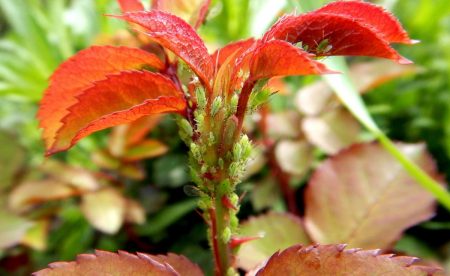
In the destruction of aphids, a large effect can be achieved by spraying plants with a stream of water. Insects that have fallen to the ground, as a rule, are not able to return to the bush and die.
For treatments, insecticides such as Kinmix, Decis Profi, Biotlin, and Aktara are most effective. But chemicals destroy the aroma of flowers and make unsuitable plant petals for culinary and cosmetic purposes. More sparing will be the use of bioinsecticides - Fitoverm, Akarin, Aktofit. In both cases, 3 bushes are processed at intervals of 7 days.
Folk remedies are also effective if you make them several treatments per season (once a week). Effective options:
- Vinegar. In 10 liters of water you need to pour 150 ml of 9% or 450 ml of 3% vinegar. This solution can not be sprayed with young shoots and buds.
- Infusion of tomatoes and garlic. 300 g of crushed heads of garlic (can be replaced with a similar volume of onions) and 400 g of chopped tomato leaves need to be poured with 3 liters of water. After infusion for 7-8 hours and straining, 7 liters of water are poured into the infusion and 1/5 of the bar of laundry soap is dissolved in it.
- Milk serum.It is used to treat tender areas of the rose bush - young leaves and buds. The tool is used without diluting with water.
- Potato infusion. Fresh potato tops need to be chopped and pour boiling water (1 kg of raw materials per bucket of water). Insist the product for 2 days, then strain and add 50 g of soap chips.
The most environmentally friendly method of controlling aphids is to attract insects into the garden, whose main food is the pest. This is a ladybug, a bug, an earwig, a lacewing, a ground beetle.
In addition to the usual sanitary measures that prevent the appearance of many pests and pathogens, for the prevention of aphids, it is recommended:
- Destruction of anthills on the site. Insects patronize the pest, because they feed on the emitted aphid.
- Planting on a flower bed with roses of plants whose smell repels aphids. It is possible to choose decorative cultures that can decorate the flower garden - lavender, nasturtium, calendula, fennel, Dalmatian chamomile, fragrant pelargonium.
Rose shield
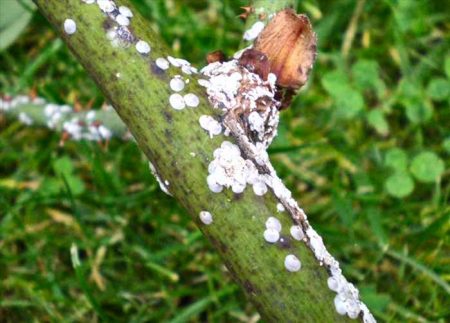
The shoots on which the pest has settled should be cut and burned. After this, it is necessary to carry out treatment with systemic insecticides that penetrate the tissues of plants, since contact preparations will not harm the insect protected by the wax “shell”. Suitable means in this case would be Aktara, Bankol and drugs based on malathion (Fufanon, Karbofos).
4-5 days after chemical treatment, the bushes should be sprayed with folk remedies. Treatments are carried out several times at intervals of 5-7 days.
Folk broths against scale insects:
- Capsicum. It is necessary to cut 0.5 kg of fresh pepper fruits, immerse in 5 liters of boiling water and cook for about 5 minutes. After cooling and filtering, the broth is ready for use.
- From tobacco. 2-3 kg of fresh tobacco leaves should be crushed and filled with a bucket of water. Infusion is required to boil for 30 minutes, then leave for 2 days.
- From celandine. 3-4 kg of chopped celandine greens should be poured with a bucket of hot water and left under the lid for 24 hours. After this, boil for half an hour and strain.
For the prevention of rosacea:
- You should not plant rose bushes next to other crops vulnerable to the pest - raspberries, blackberries, strawberries. When insects appear, it is necessary to carry out preventive treatment of all affected plants. Bushes of wild rose hips, if they are near the site, it is advisable to uproot.
- Avoid excessive nutrition of rose bushes with nitrogen.
- Once every six months, support plants with immune stimulants. For example, "HB-101", "Amulet".
- Giving roses full nutrition with potassium. In case of adverse conditions or depletion of plants, additional foliar top dressing with potassium sulfate should be done.
Nematode
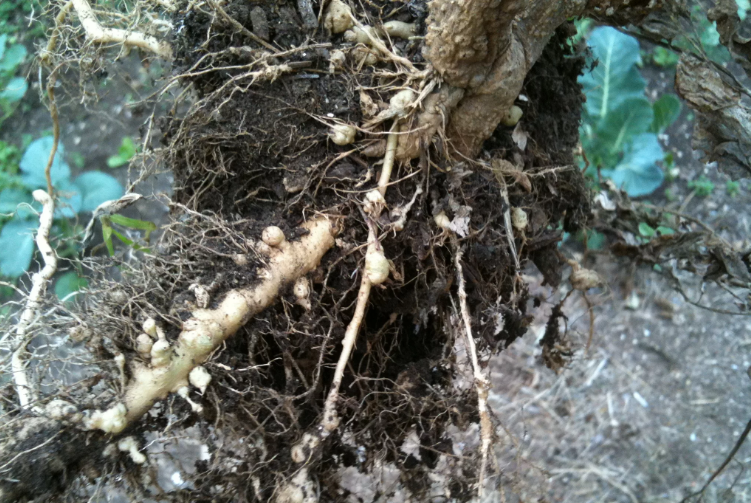
Effective methods to combat this pest do not exist. It is necessary to focus on stopping the spread of nematodes. The affected bushes should be dug up and destroyed (burned), and the soil on which they grew should be abundantly poured with boiling water. After the onset of cold weather, you need to dig the soil on a full bayonet of a shovel so that the surviving pests freeze out.
At the place where the affected roses grew, it is advisable to sow calendula or marigolds. Do not plant gladioli, phlox or peonies in the infected area. Safe nematodes for annual herbs.
Gardeners reviews
Marina, 36 years old:
“In plant tinctures for spraying bushes against a spider mite, it is useful to add 300 ml of alcohol (pure) to a bucket of solution. The effect of such a tool will be higher. Alcohol works best against ticks, but it can also be used in the fight against scale insects - alcohol dissolves the “shield” of the pest, making it vulnerable to contact drugs. We do this: first you need to moisten the bushes with an alcohol solution, and the next day to spray with an insecticide.Due to this, it is possible to reduce the number of chemical treatments from the prescribed three to one, but after a short break you need to continue spraying with "folk" means. To kill ticks, alcohol can also be used separately. It destroys larvae and eggs, due to this, it is no longer necessary to repeat the chemical treatment (it is usually aimed at the "second generation"). Less chemistry means less harm to roses. ”
Natalia, 44 years old:
“Everyone knows about the benefits of ladybugs and lacewings in the fight and prevention of aphids, but not everyone knows how to attract them to their site. These insects love plants with flowers of yellow and orange hues (for example, calendula, marigolds, tansy, clover), and they also prefer umbrella ones - carrots, fennel dill. “Attractive” plants need to be stirred with islets throughout the site, including in the flower garden. Another useful and lesser-known insect is the earwig. Likes to settle in sawdust. You can put several boxes with shavings in the flower garden. ”
Margarita, 32 years old:
“There is an interesting working recipe for a spider mite decoction. The tool is impractical because it needs cyclamen tubers, but in advanced cases, if you really do not want to resort to chemistry, you can try it - it works perfectly. I take about 100 g of tubers per liter of water, cut into cubes and boil for 40-50 minutes. I leave to insist on 24 hours. The tool is ready. "
Whatever the reason for the appearance of yellow leaves in a garden rose, if this occurs in the second half of summer, the affected plant should be especially carefully prepared for wintering. Weakened roses are not only vulnerable to diseases and pests, but also lose their resistance to low temperatures. It is necessary to support bushes with immunomodulators and potassium nutrition.

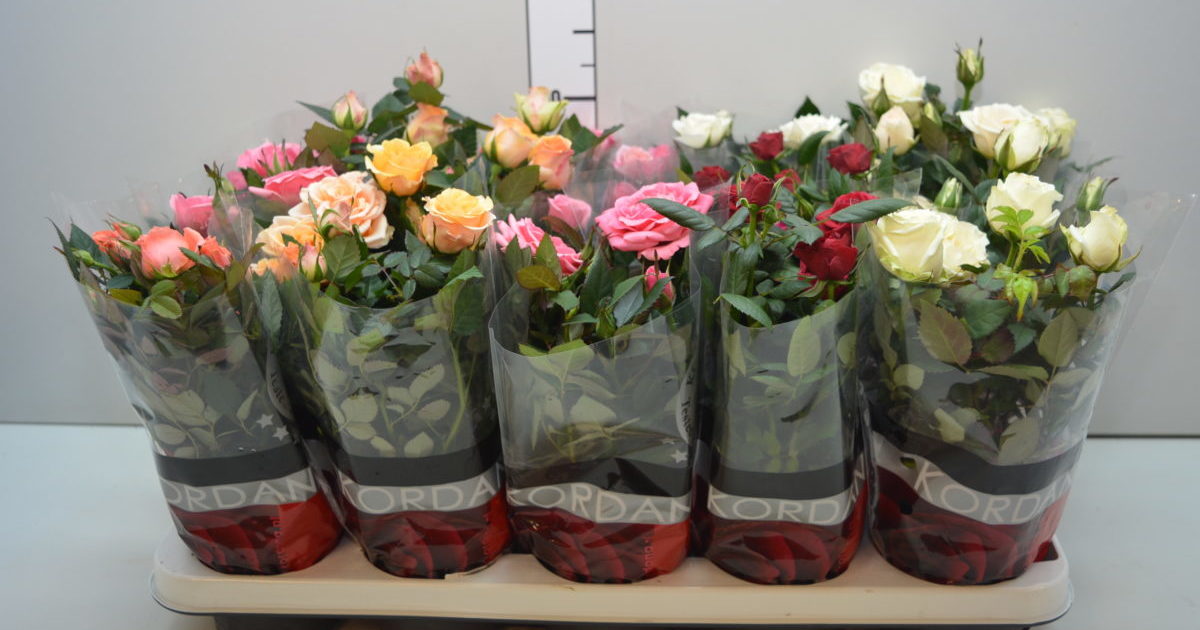
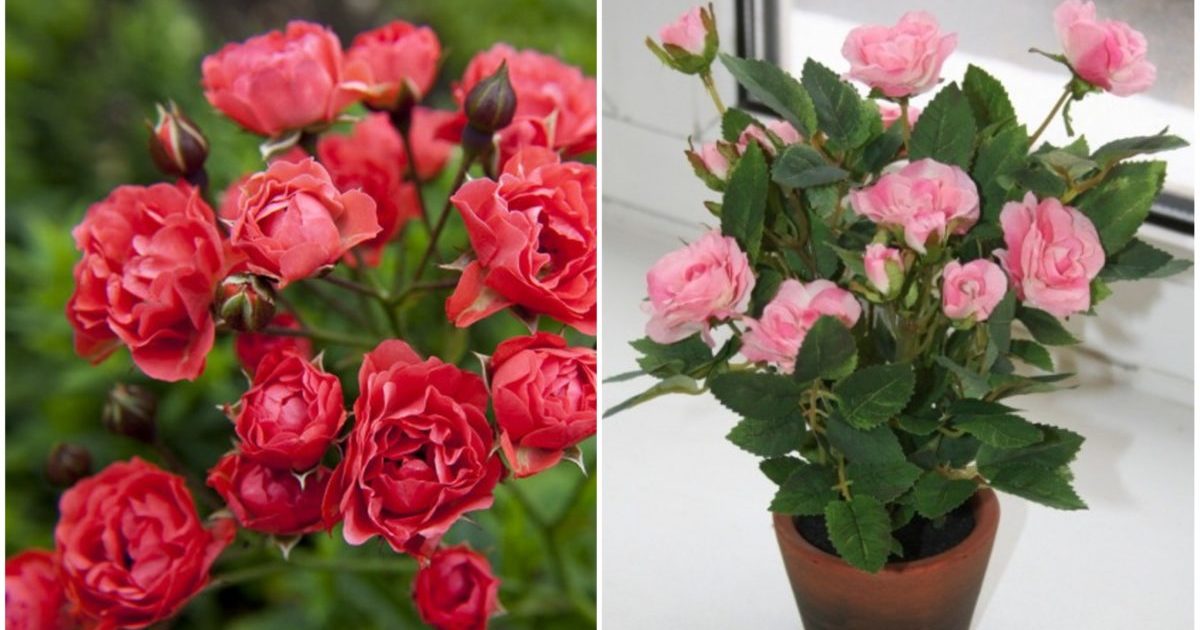
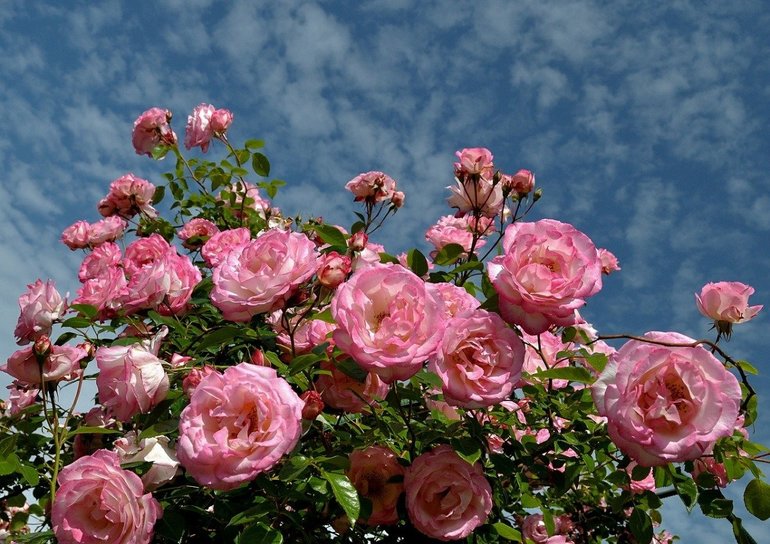
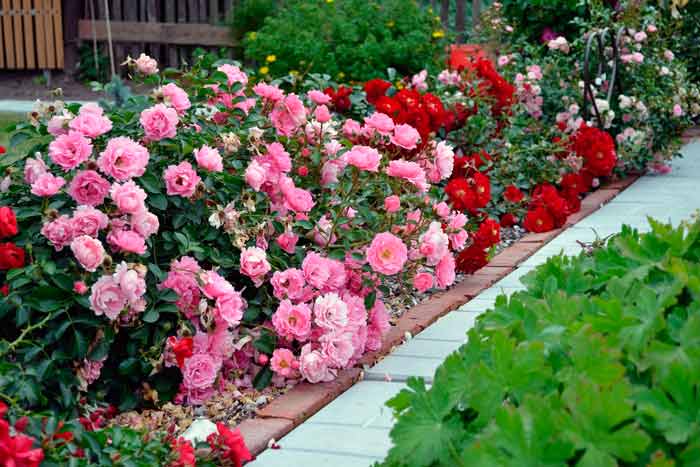 Shelter of roses for the winter: at what temperature does the robot hold
Shelter of roses for the winter: at what temperature does the robot hold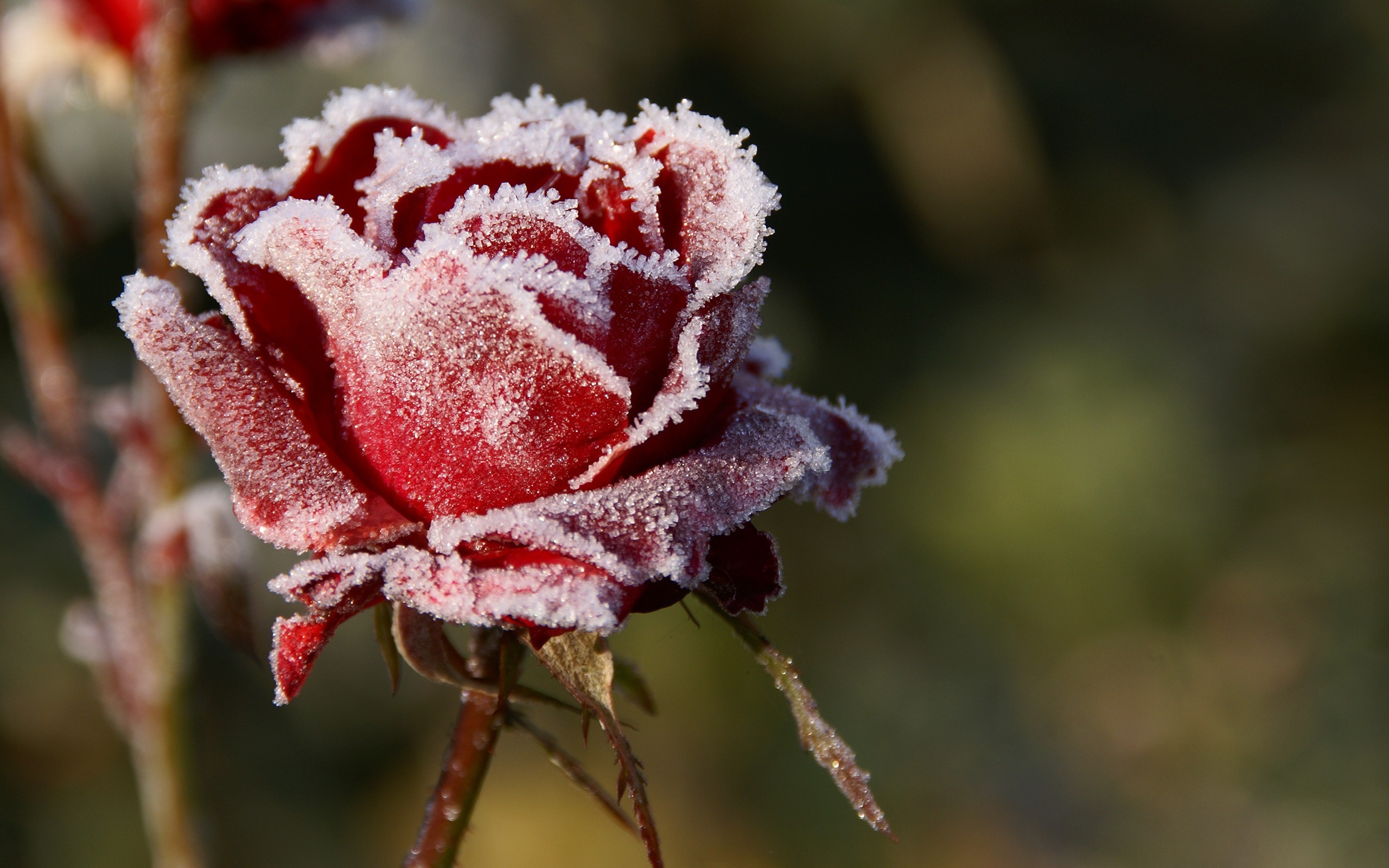 How to prune roses in the fall: timing, pruning rules, pros and cons
How to prune roses in the fall: timing, pruning rules, pros and cons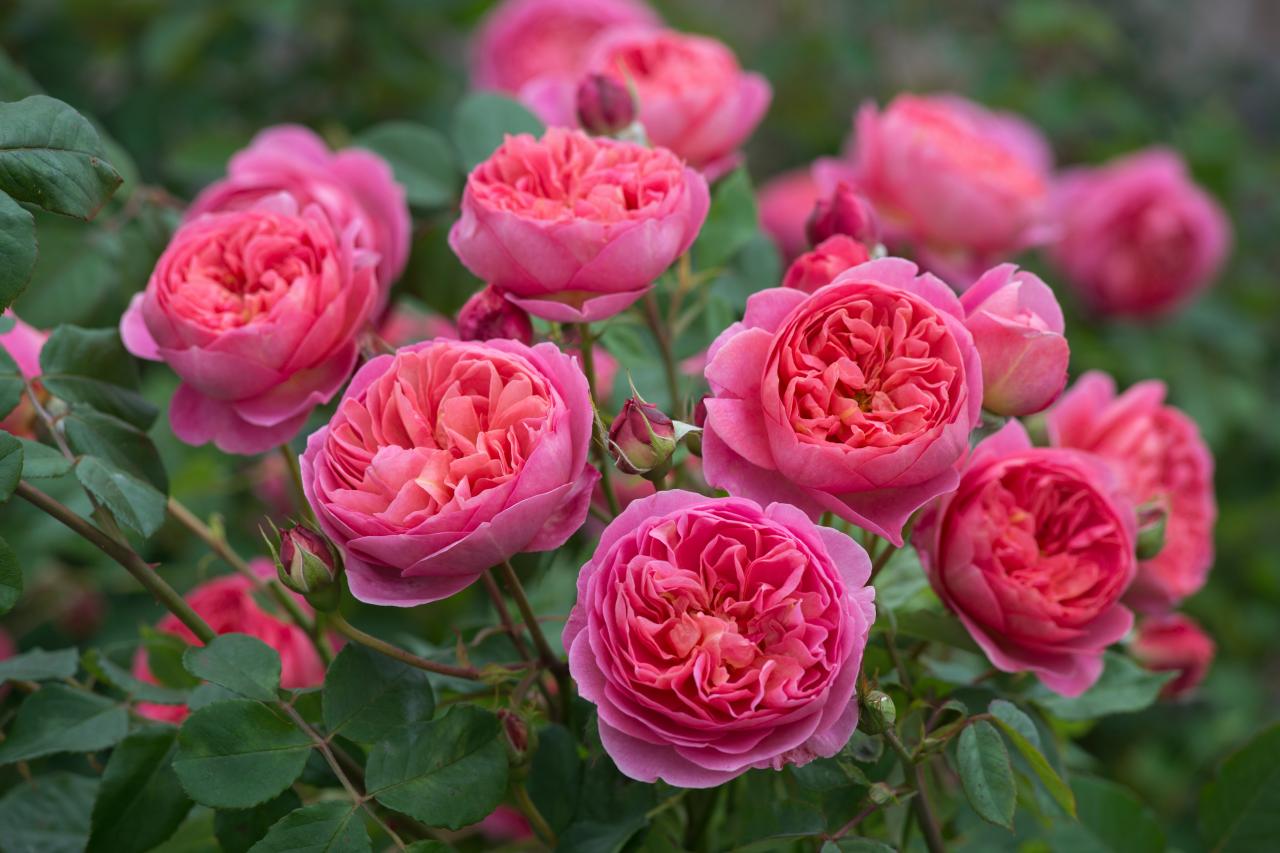 What are the varieties and types of roses
What are the varieties and types of roses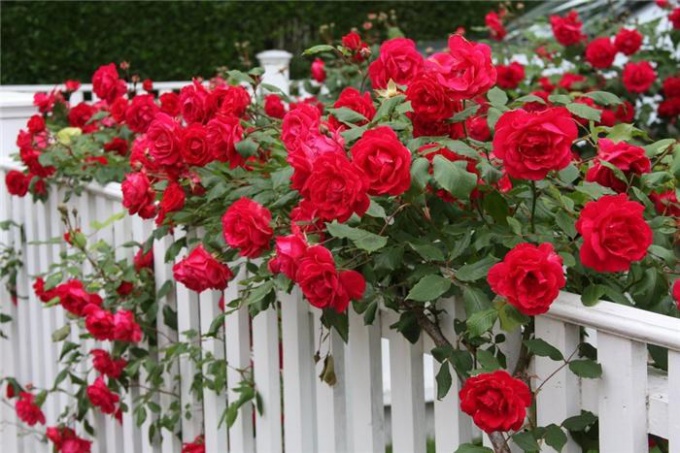 How to process roses with iron sulfate in autumn: proportions, advantages and disadvantages
How to process roses with iron sulfate in autumn: proportions, advantages and disadvantages